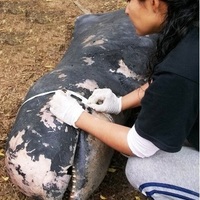- Universidad de Las Palmas de Gran Canaria, Biología CC del Mar, Department Memberadd
Research Interests: Business, Geography, Law, Corporate Governance, Political Science, and 15 moreEnvironmental Policy and Governance, Marine Mammals, Ecuador, Cetaceans, Dolphins, Fishing, Bycatch, Fishery, Fisheries Bycatch, Humpback whales, Socioenvironmental Issues, Marine Policy, Fisheries Governance, Small-scale and artisanal Fisheries, and ENVIRONMENTAL SCIENCE AND MANAGEMENT
El elefante marino del sur es el pinnípedo más grande del mundo; tiene un comportamiento de dispersión y presenta largos movimientos migratorios en los océanos en busca de presas en las áreas de alimentación y zonas de hábitat idóneo. En... more
El elefante marino del sur es el pinnípedo más grande del mundo; tiene un comportamiento de dispersión y presenta largos movimientos migratorios en los océanos en busca de presas en las áreas de alimentación y zonas de hábitat idóneo. En este estudio recopilamos y analizamos los registros de su presencia en Ecuador entre 1998 y 2020. Realizamos entrevistas, revisiones bibliográficas y visitas a ciertos sitios de registro. Registramos 15 individuos en las provincias de Los Ríos, Guayas, Galápagos y Esmeraldas. La presencia de estos individuos probablemente está relacionada con anomalías térmicas oceánicas causadas por eventos de El Niño-Oscilación del Sur y La Niña, que bien pueden haber modificado el movimiento y dispersión de esta especie fuera de su rango de distribución normal. Los avistamientos de M. leonina en Ecuador corresponden a individuos en reposo y todos abandonaron sus sitios de descanso días después de su arribo. Solo en una ocasión, un macho subadulto reportado en jul...
Alava, J.J.; Merlen, G.; Rosero, P.; Avila, I.C.; Salazar, S. 2022. A Juan Fernández Fur Seal (Arctocephalus philippii, Peters, 1866) in the Galápagos Islands: Insights from the First Anecdotal Observation in the Last Century. Aquatic... more
Alava, J.J.; Merlen, G.; Rosero, P.; Avila, I.C.; Salazar, S. 2022. A Juan Fernández Fur Seal (Arctocephalus philippii, Peters, 1866) in the Galápagos Islands: Insights from the First Anecdotal Observation in the Last Century. Aquatic Mammals. 48(6): 559-564. https://doi.org/10.1578/AM.48.6.2022.559
Research Interests:
Alava, J.J.; Merlen, G.; Rosero, P.; Avila, I.C.; Salazar, S. 2022. A Juan Fernández Fur Seal (Arctocephalus philippii, Peters, 1866) in the Galápagos Islands: Insights from the First Anecdotal Observation in the Last Century. Aquatic... more
Alava, J.J.; Merlen, G.; Rosero, P.; Avila, I.C.; Salazar, S. 2022. A Juan Fernández Fur Seal (Arctocephalus philippii, Peters, 1866) in the Galápagos Islands: Insights from the First Anecdotal Observation in the Last Century. Aquatic Mammals. 48(6): 559-564. https://doi.org/10.1578/AM.48.6.2022.559
Research Interests:
Research Interests:
Research Interests:
Research Interests: Geography and Humanities
Research Interests: Geography and Humanities
Orcinus orca (Linnaeus, 1758). Caracterización de los mamíferos en los biomas costeros y tierras bajas de la provincia de El Oro. Capítulo IV. En MAMÍFEROS DE LA PROVINCIA DE EL ORO, Una guía de identificación de especies de mamíferos del Páramo al Mar. Publicación Miscelánea N° 8: Serie de Publi...more
Research Interests:
Research Interests:
Research Interests: Business, Geography, Law, Corporate Governance, Political Science, and 15 moreEnvironmental Policy and Governance, Marine Mammals, Ecuador, Cetaceans, Dolphins, Fishing, Bycatch, Fishery, Fisheries Bycatch, Humpback whales, Socioenvironmental Issues, Marine Policy, Fisheries Governance, Small-scale and artisanal Fisheries, and ENVIRONMENTAL SCIENCE AND MANAGEMENT
The interaction of small cetaceans with fishing gear is considered a major conservation issue worldwide. Between April and September 2009 a study was conducted to assess the level of bycatch in artisanal fisheries of Puerto Lopez, Salango... more
The interaction of small cetaceans with fishing gear is considered a major conservation issue worldwide. Between April and September 2009 a study was conducted to assess the level of bycatch in artisanal fisheries of Puerto Lopez, Salango and Machalilla, on the central coast of Ecuador. For this purpose 185 trips of boats using gillnets and purse seine nets as fishing gear were monitored. During the study, seven cetaceans of four different species were caught: two bottlenose dolphins Tursiops truncatus (28.57%), one dwarf sperm whale Kogia sima (14.28%), two Risso's dolphins Grampus griseus (28.57%) and two spotted dolphins Stenella attenuata (28.57%). All cases occurred in gillnets with 5-inches wide mesh. The estimated average mortality rate was 0.07 dolphins/day. August was the month with the highest bycatch rate (0.18 dolphins/day).These results indicate an increase of the bycatch rate compared with previous studies. Fishermen showed interest and willingness to collaborate o...
